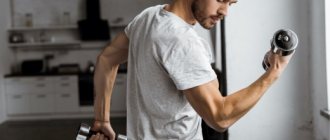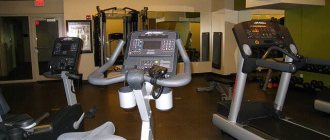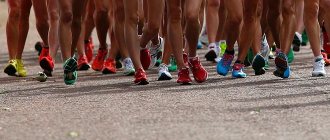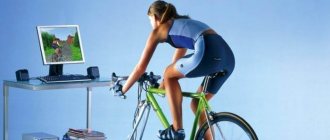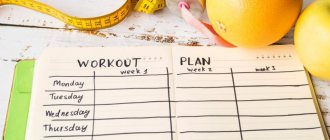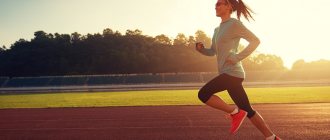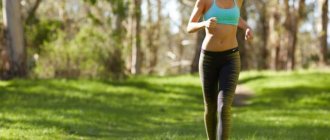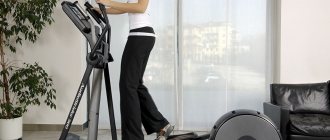In pursuit of an ideal figure, people are ready to spend a lot of money and resort to complex exercises and techniques. But for some reason we forget about a simple, natural, accessible to everyone and, most importantly, effective method of losing weight - walking. Indeed, when used rationally, it allows you to achieve amazing results.
Walking is one of the safest methods of combating excess weight. It does not require special training, equipment or specific inclinations - everyone can walk, this is a mechanism of movement inherent in nature. In addition to losing weight, regular exercise will develop the body's abilities.
Author of the article
Kislitsa Evgeniy Vladimirovich
Surgeon. Author of publications in periodical medical journals, reports at medical conferences and congresses. Master of therapeutic and cosmetological massage with more than 3 years of experience. Repeated winner of regional kettlebell lifting competitions.
Articles written
2
Benefits of walking
Regular walking, especially in the fresh air, has a positive effect not only on physical but also on mental health. With its help you can:
- strengthen the cardiovascular system - increase exercise tolerance, speed up blood flow, maintain optimal blood pressure, train the heart muscle. Regular walking is also an effective way to prevent cardiovascular diseases;
- improve the condition of the respiratory system. While walking, the load on the respiratory system increases, the volume of circulating blood increases, which develops endurance, increases tolerance to physical activity, and ensures the active functioning of the lungs in tandem with the heart;
- regular physical activity has a positive effect on the condition of the muscles : metabolism increases in the muscles, more blood flows to them, they receive an incentive to grow, become stronger and more resilient;
- activation of the muscles of the lower extremities , which significantly increases even with normal walking, stimulates blood flow in the legs, has a beneficial effect on the condition of the venous valves, which prevents varicose veins of the lower extremities;
- With the help of walking, you can get rid of fat deposits almost anywhere . Just a 15-20 minute walk at an average pace is enough to burn up to a hundred kcal;
- Walking is especially beneficial for men. This not only has a beneficial effect on your figure, but also prevents blood stagnation in the pelvic organs (which is one of the reasons for the development of potency problems), which allows you to strengthen and prolong reproductive health;
- regular dosed physical activity for at least 15 minutes a day leads to the release of the happiness hormone into the blood . This allows you to effectively resist stress and maintain mental balance;
- Walking is effective in the fight against osteochondrosis. Even the loads from your own body weight are enough to maintain the physiological nutrition of bone tissue, normalize the processes of its formation and destruction;
- Regular walks will strengthen your immune system ;
- after physical activity, more sound sleep ;
- activation of blood flow and acceleration of metabolism have a positive effect on the functioning of the nervous system, especially on brain activity;
- Hiking has virtually no contraindications .
Video from the European Center for Vertebrology about the benefits of walking and the difference with running ( a vertebrologist is a specialist who deals with problems of the spine):
Doctors' recommendations
To ensure an excellent training effect, you need to follow a few simple tips:
- You need to run on an empty stomach . The load after eating is very difficult, it forces the body to work more intensely and disrupts food processing. Therefore, it is better to run before breakfast. On the day of training you should have a protein breakfast. An athlete's diet should not contain fatty or fried foods. After sports, porridge with milk and potatoes with meat are suitable.
- A good night's sleep is essential. An adult needs about 8-9 hours per day. If less time is spent on sleep, then negative changes are observed in the body.
- It is advisable to get rid of bad habits . Alcohol and smoking can worsen a person's condition. With such habits, it is more difficult for a person to move and tune in to constant training.
Walking and running have almost the same benefits. Compliance with the norm of steps per day for women allows you to quickly gain a slim figure and maintain it.
Article design: Anna Vinnitskaya
How much weight can you lose by walking?
You can lose an unlimited number of kilograms from walking. The amount of fat lost depends on the individual characteristics of the body. That is, weight loss is observed until the moment when the body itself considers it necessary to stop losing weight. This happens when a weight loss threshold is reached. If a person continues to lose weight, they are considered to have a disease or pathological weight loss.
It is important to study at the same time. The greatest benefits from walking can be achieved if physical activity is performed at the same time, since the body gets used to such a daily routine, the metabolism is activated exactly at a certain time: the transmission of nerve impulses accelerates, hormones are released, the work of the cardiovascular system is enhanced, brain, etc.
Tips for beginners
Anyone can practice walking to lose weight: both a pensioner and a very overweight person. This is the most affordable way to lose weight of all known. But before starting training, it is recommended that you read the information below.
How long to walk
The walk can last for an unlimited time. There is no upper limit on duration or distance: travel as many kilometers as you feel necessary. The main thing is not to overdo it. Classes begin with hikes over shorter distances, then gradually lengthen them. The body itself will tell you when you need to increase the duration of your workouts.
For an untrained person, a speed of 3-4 km per hour or walking in place at his usual pace is sufficient to achieve the effect. More trained persons or representatives of physical labor can move at a speed of 6-8 km/h.
If you experience discomfort, pain, severe palpitations or shortness of breath, it is recommended to stop any physical activity. If the condition does not improve after this, you should seek medical help.
To “start” fat burning processes, you need to walk for at least an hour a day. In 30-40 minutes, the body, in order to meet increased energy needs, will be forced to switch to breaking down fat reserves.
Accordingly, already at the initial stage of training, about half an hour will be allocated for burning fat, which will allow you to effectively fight excess weight.
Over time, as opportunities grow, walks can be increased. You also need to gradually increase the pace of movements. You yourself will feel the need to increase the duration and intensity of your studies, which will be expressed in an ever-increasing desire to go further, which will be increasingly difficult to resist. The need to increase the intensity and time of training will be indicated by the ease of tolerance of previous loads, the feeling that not everything has been accomplished and there is an opportunity to do more.
If you want to burn more calories, it is advisable that walking becomes a part of your life: walking to the store, place of work, amusement park, restaurant, cinema, etc.
We provide you with an approximate walking program for a month to burn calories. The given program is an example - it is not necessary to repeat it completely. All training must be individualized. The intensity of the exercise should be adjusted in accordance with the reaction and needs of the body.
Week 1:
- Day 1. Slow walking for 30-40 minutes (the day is considered a preparatory day; based on its results, the ability to train further is assessed).
- Day 2: Walk slowly for an hour.
- Day 3. Slow walk 1-1.5 hours.
- Day 4. Workout at a moderate pace for about half an hour (the possibility of increasing the load is considered).
- Day 5. Moderate walking pace for 1-1.5 hours with rest breaks.
- Day 6. Walk at a moderate pace for 1.5-2 hours with breaks.
- Day 7. Rest or walk at a slow pace.
Week 2:
- Day 1. Walking at a moderate pace for at least 1 hour (then walking should be at least 1 hour per workout), performing breathing exercises.
- Day 2. Walk with interval walking + breathing exercises.
- Day 3. Interval training with breathing and light physical exercise (jumping, squats, etc.).
- Day 4. Walk at a high pace of walking + breathing exercises (tolerance of a high pace of walking is assessed).
- Day 5. Training at a moderate pace with free exercises.
- Day 6. High-intensity class + light exercise.
- Day 7. Rest or walk at a moderate pace.
Week 3:
- Day 1. Interval training with strength exercises.
- Day 2. High-intensity walking with light physical exercise (up to half an hour).
- Day 3. Walking at a moderate pace and strength exercises + breathing exercises.
- Day 4. Walk at a high pace with breathing exercises.
- Day 5. Interval walking, strength exercises (10-15 minutes).
- Day 6. High-intensity walk, free exercise.
- Day 7: Rest or walk at a moderate pace.
Week 4:
- Day 1. Interval training with strength and breathing exercises.
- Day 2: High-intensity walk with floor exercises.
- Day 3. Interval walking + strength exercises for at least 30 minutes.
- Day 4: Interval training, free exercise or breathing exercises.
- Day 5. Walk at an intense rhythm with strength training.
- Day 6. Interval walk, free exercises.
- Day 7. Rest or easy walk.
When to go
It is advisable to choose the training time according to individual biorhythms rather than the general population. Although there is an increase in the concentration of hormones in the body in the pre-dawn hours, which is a kind of wake-up signal, not everyone is comfortable waking up early in the morning. A similar picture is observed with going to bed. It is important to take into account the work schedule, since after an active workout it can be difficult to “join” it.
The advantage of morning workouts over evening classes is the speedy transition to the “calorie burning” mode. However, training on an empty stomach is prohibited, although such an approach may seem irrational. Exercising on an empty stomach disrupts the functioning of the gastrointestinal tract and leads to disruption of its physiological rhythm of work. Therefore, before your morning workout, it is advisable to have a light breakfast.
Evening exercises allow you to get rid of negative emotions accumulated during the day, relieve mental and physical stress, and have a beneficial effect on sleep. Their disadvantage is the longer process of “building up”, the need for a more thorough warm-up. Also, the body takes longer to get used to the evening exercise routine. It is important that training takes place no later than 3 hours before bedtime, otherwise you can disrupt biological rhythms and harm the cardiovascular and endocrine systems.
It is highly undesirable to train at lunchtime, since then the greatest solar activity is observed, which negatively affects the body.
Exercising in the heat is especially dangerous, as it leads to severe loss of fluid, puts excessive strain on the heart and respiratory system, and can lead to overheating and other dangerous consequences.
Where to go
It doesn’t matter where the classes take place. You can walk anywhere convenient:
- at home;
- on the staircase;
- on the street (away from the roadway);
- at the stadium;
- in the gym on a treadmill;
- on the bank of a river or lake;
- in the park.
The main condition is the presence of clean air, since heavy gases and impurities from the air entering the lungs impair breathing, additionally load the cardiovascular system, and reduce the effectiveness of training.
Clothes for walking
Proper walking for weight loss begins with choosing clothes and shoes. The latter plays a special role. It must correspond to the size (no squeezing or dangling of the foot), provide fixation of the ankle joint, but not limit movement in it. It is undesirable to wear shoes with completely flat soles, since they do not allow physiological distribution of the load on the foot and lead to compression in the direction from bottom to top. Also, shoes should be soft. It creates the effect of a soft spring - it performs a shock-absorbing function. Otherwise, the risk of developing flat feet, injuries, and increased wear of articular surfaces increases.
Shoes should not be too heavy or light - they need to be felt. It is advisable to use sneakers. They should be changed every 400-450 km, because by this time they have time to wear out and lose their shock-absorbing function.
Clothes should be comfortable: not tight to the body and not hanging. Natural fabrics are recommended because they allow air to pass evenly (the fabric “breathes”) and ensure normal sweat production and evaporation (the body cools naturally). Dark fabrics heat up more, so wearing them in hot weather is not advisable. Light-colored clothing heats up less, so it is more suitable for activities in the warm season. In cold weather, it is recommended to wear hats.
Clothes and shoes must be appropriate for the weather, otherwise training will lead to illness.
Warm-up
Warm-up is a must. It is especially relevant for interval training, walking at a fast pace or on stairs. Loading on unheated muscles leads to excessive damage to their fibers and increases the recovery period. Sudden stress on joints, ligaments and bones can cause severe damage. Without warming up, the likelihood of injury increases by 2-3 times.
You should start the lesson with light breathing exercises, warming up movements in the joints (necessarily in large ones), rotations of the neck and pelvis, squats, and muscle stretching. Everything is like in school physical education classes. Then they move on to slow walking for a short distance, soon increasing the pace. Be sure to monitor your health, breathing and heartbeat. Afterwards, you can rest for up to 5-8 minutes before the main workout. In addition, warming up will allow you to burn more calories.
Walking technique
It is extremely important to know how to walk correctly. Although this seems strange, many people do not know how to walk, which is why exercise will only be harmful to their health.
The correct walking technique is as follows:
- Correct posture. You need to stand straight, do not arch your back or lean forward, otherwise the stress on your feet and spine will increase by 1.5-2 times, which increases damage to bone and cartilage tissue. Correct posture will ensure easy breathing and avoid pain in the legs and back.
- Chin parallel to the ground, gaze straight. This ensures reliable fixation of the cervical spine, which minimizes the likelihood of injury. Looking ahead will allow you to respond in a timely manner to the appearance of an obstacle.
- Shoulders relaxed. They are located freely or slightly retracted posteriorly (depending on the flexibility of the joints). Walking with a tense shoulder girdle causes excessive shock to internal organs.
- The abdomen is tucked, but not tense. This achieves the effect of a pillow - the internal organs are maintained in a physiological position, their shaking is minimized.
The efficiency of burning fat while walking or running increases when you engage your arms. According to various sources, this increases the effectiveness of classes by 4-10%. The limbs are bent at the elbow joints at a right angle. If this technique is too exhausting, you can use your hands for 5-15 minutes until the body gets used to the increasing loads.
- It is forbidden to clench your fists. Clenched fists increase blood pressure, which is highly undesirable. It is recommended to keep your elbows close to your body.
- The feet should be parallel to each other. This will protect the joints from premature wear.
- Walking involves rolling from heel to toe. First, the heel is lowered, then the foot rolls towards the toe. If there is simultaneous contact with the surface of the entire foot, it is worth reviewing the technique or changing shoes.
- The steps are moderate. A step that is too long or short disrupts balance and increases the load on the foot. The repelling limb should be at a greater distance from the body, because the pushing force is placed on it.
- Breathing should be of moderate depth and uniform. Sharp inhalations and exhalations lead to shortness of breath and the training will have to be stopped. The appearance of severe shortness of breath, discomfort or pain in the lungs is a signal to reduce the intensity of training or to stop it.
- The heart rate should not exceed the maximum for a particular age.
- There is a concept of the “fat-burning pulse zone” - the heart rate at which maximum burning of fat reserves is achieved. The “fat burning zone” is considered to be a heart rate corresponding to 60-70% of the maximum safe frequency. The “fat burning zone” can be determined using the formula 220 beats/min. subtract the age in years (get the safe heart rate limit for a specific age) and multiply by resp. percent.
- Walking speed should be increased gradually.
How much water to drink
Replenishment of water and mineral losses is mandatory. Most of the salts dissolved in water are excreted from the body through sweat. In the absence of their supply, problems with the heart and nervous system are observed, and seizures may develop.
You can drink before starting a workout. But a little. Otherwise, breathing is impaired, and the load on the heart and kidneys increases significantly. It is recommended to drink small sips (3-5) during training. Do not drink too much water, otherwise you will have to stop the activity.
After training, it is necessary to restore the water-mineral balance. Freshly squeezed juice or mineral water (preferably without gas) will help. You should not drink a lot of liquid at once. It is better to drink the same amount in short periods of time. For the average person, 0.5 to 1.5 liters of water per workout is enough to replenish fluid loss.
Drinking sports drinks with caffeine is highly discouraged. Because they overload the heart muscle and lead to increased blood pressure.
Goal while walking
Each workout should pursue a specific goal, which will make it more effective and make it easier to bear the load. It is recommended to set yourself a small task each time. For example: walk to a certain street, cover 10 km or climb a hill 5 times. This approach will allow you not to miss training, develop resilience and the habit of achieving what you want. Quite quickly, the psyche will get used to the formation of regular tasks, which will allow you to constantly improve your results.
Motivation
Walking is an affordable and completely free way to normalize body weight. The only thing required is desire. Regular exercise will not only help you get rid of fat deposits, but also improve your health, develop strength and endurance. It has been proven that playing sports builds strong-willed qualities, allows you to fight stress, and discover hidden potential. At the very least, it will become a useful hobby. If you walk accompanied by music or audio books, you can significantly expand your worldview.
Joint training allows you to make new acquaintances, motivate each other, and strengthen relationships. It is noted that during joint exercises, load tolerance increases, therefore, productivity increases.
Types of walking
To lose weight, you can practice different types of walking. The main thing is to start with smaller loads and gradually move on to larger ones. Below are the most suitable options in accordance with the level of physical fitness of the student.
Scandinavian
Nordic walking has no contraindications, so it can be practiced by both young and old people. However, it is advisable for people who are very overweight to be careful and not overdo it with loads, since walking with poles allows you to cover long distances and you can overdo it with loads, which can cause joint pain the next day.
Nordic walking with poles involves up to 90% of the muscles throughout the body. This allows you to get rid of fat deposits faster than with a regular walk. Advice from a doctor-instructor in the video:
The technique is:
- When moving, the feet roll from heel to toe;
- one arm is extended forward and slightly bent at the elbow joint;
- the second is held parallel to the hip of the same name and pulled back with it;
- alternately walk with changes in the position of the limbs.
Sports
During race walking, almost all muscles are involved in work, since training requires active work with the arms. This type of walking is quite fast, so it requires good physical preparation; you should not start training immediately with this option; it is advisable to prepare for it. Also, training is not advisable for diseases of the leg joints, severe osteochondrosis, and unstable blood pressure. Effectiveness depends on body weight.
Technique:
- the feet perform rolling movements in the heel-toe direction;
- at the last point, force repulsion is performed;
- they walk often and not far;
- arms are bent at the elbows, limbs move from the waist to the chest;
- move at speeds over 6-7 km/h.
On the stairs
Walking on stairs is suitable for lovers of an active lifestyle and advanced athletes. It is contraindicated for people with health problems (especially with the heart, lungs, joints). Calorie loss is determined by body weight. It is calculated that for climbing stairs with a frequency of 60-70 steps/1 min. 0.14 kcal/1 kg of body weight is spent. Depending on the intensity, you can adjust fat burning. For maximum weight loss, it is recommended to go up and down stairs at a fast pace. Exercising at a calm pace allows you to strengthen the muscles of your limbs.
Long walk
A regular walk over long distances is suitable for any person (even with low physical fitness and those for whom other types of exercise are contraindicated). Technically, it is a normal walk, but over long distances (see “Walking Techniques”). Average speed is within 3-5 km/h. Such exercises allow you to prepare for heavy loads and strengthen your muscles. For people with significant excess weight, such training will allow you to effectively lose weight with measured and gradually increasing loads.
Interval walking
Interval movements can increase calorie loss by up to 15%. Intervals imply a change from a moderate pace to a fast one: the speed from 3-5 km/h in a short time increases to 6-9 km/h. Walking includes 1 min. fast pace with a transition to moderate for 2-4 minutes. Then they switch to a fast pace again. The interval method leads to a significant increase in energy consumption and allows you to speed up metabolic processes throughout the day. It is not advisable for people with health problems to resort to the intensive interval method.
On the spot
If there is no opportunity or desire to go outside, you can resort to home walking, preferably on the spot, since it is best suited in limited space. The effect of such training is less pronounced than when exercising on the street. Walking in place looks like moving your hips with high knees and no horizontal movement. To increase the loss of fat deposits, it is recommended to include your hands in the work. Technically, walking in place is similar to normal, but a special role is given to the high rise of the legs bent at the knees.
An effective way to exercise at home is the method of the famous trainer Leslie Sanson - “Walking for weight loss with Leslie.” It suits almost everyone, because... classes are divided into “miles” corresponding to the level of training and endurance of the trainees. The peculiarity of the technique is a gradual increase in loads with good tolerance. Training using the Sanson method allows you to burn from 150 to 600 kcal per session.
https://blog.viralnews.network/
Uphill or incline on a treadmill
Exercising on an incline treadmill or walking uphill can significantly increase the efficiency of fat burning. The higher the slope, the more difficult it is to move. But such training is only suitable for relatively healthy individuals. Young people tolerate it more easily, respectively. they can travel long distances. Due to the pronounced load, training is contraindicated in the presence of cardiovascular, pulmonary, endocrine pathologies, problems with the kidneys, joints and bones. Walking on an inclined surface is considered one of the most effective for losing weight. Read more about how to lose weight on a treadmill.
Walking with weight
It is more efficient than the previous version. Performance directly depends on the speed, weight used, continuity of exercise, and the presence of rest breaks. During training, the load on the heart, blood vessels, respiratory, endocrine systems, kidneys, and muscles increases significantly. Therefore, walking with weight is contraindicated for persons with pathologies or diseases of these organs.
The technique is similar to standard walking, but special attention is paid to the level position of the neck and back, and rolling the foot from heel to toe. If you are very tired, you can bend your legs a little at the knee joints, but it is better to rest.
How many calories can you burn
The effectiveness of training is measured in calories lost per 1 hour:
| Type of walking | Kcal loss per 1 hour of training |
| Scandinavian | up to 400 |
| Sports | 400-500 |
| On the stairs | 400-600 |
| Long walk | 200-250 |
| Interval | 500-600 |
| On the spot | 150-200 |
| Uphill or incline on a treadmill | 450-600 |
| With weight | 500-700 |
Efficiency depends on body weight, duration and intensity of exercise, the presence or absence of weights, and the characteristics of the surface used.
Norm of steps per day for women. WHO recommendations
The norm of steps per day for women is 10,000. This is a generally accepted indicator, but is not considered universal. The norm is determined by health and age.
The following table will help determine the optimal indicator:
| Age | Number of steps |
| 18-35 | Up to 20,000 |
| 35-50 | Up to 15,000 |
| Over 50 | Not less than 8,000 |
These indicators are suitable for healthy people. However, the number of steps may vary depending on your health condition. For example, for some ailments, the doctor recommends slightly reducing physical activity, but it should still be there.
Nutrition and sleep
No amount of physical exercise will allow you to lose weight if there is an excessive intake of calories into the body. You can calculate your daily calorie intake using an online calculator. Those who want to lose excess weight need to reconsider their diet and keep a strict count of the foods consumed per day. At the same time, it is forbidden to starve and overeat, since this will not only not lead to the desired result, but will also harm your health.
Walking exercises for weight loss will be effective only if they are regular and follow proper nutrition. The body must satisfy energy needs by burning fat deposits.
In the morning, it is advisable to eat 30-40 minutes before the start of training (a small meal of light food, for example, a diet shake). It is not recommended to eat food 1.5-2 hours before evening training. You can eat in 20-30 minutes. after finishing classes. At this time, the “protein-carbohydrate window” is activated, when foods are absorbed best.
| Prohibited Products | Allowed food |
| Quickly digestible carbohydrates (sweets, chocolates, bars, snacks, corn flakes) | Slowly digestible carbohydrates (buckwheat, pearl barley, oatmeal, rice, millet porridge) |
| Sweet carbonated drinks | Mineral water |
| Fatty meats | Lean meat (especially chicken) |
| Fatty fish | Low-fat fish and seafood |
| Flour | Products made from peeled flour |
| Fat cheese, sour cream and other dairy products | Low-fat cottage cheese, cheeses, milk, sour cream, etc. |
| Alcoholic drinks | Fruits and vegetables, beans |
| Caffeinated drinks | Tea without sugar |
During sleep, damaged tissues are restored, muscle fibers grow, energy reserves are replenished, digestion is enhanced, and the nervous system rests. It is recommended to sleep at least 7 hours a day, but no more than 9-10.
Walking stage
From the previous points, you should have realized that, in fact, it is much more difficult to fix the body position in a handstand. It is very difficult to maintain balance and balance, so as soon as you stand on your hands without support, as a rule, you will immediately begin to automatically walk in order to somehow hold on. Most likely, you will begin to walk with your legs bending forward.
Remember, you can walk on your hands automatically, but the skill of standing still takes longer to practice by balancing your fingers.
Exercises for tone
The combination of walking and other exercises will allow you to quickly get rid of excess weight, maintain muscle and skin tone, and avoid “overwork” of the nervous system from the same type of stress. You can look at our selection of exercises for morning exercises.
Here are a few simple exercises that you can do at home, on the street or in the gym:
- circular movements in the joints clockwise and counterclockwise;
- deep squats with legs wide apart (if impossible, regular squats will do);
- According to reviews, the “bicycle” exercise helps to lose weight. You need to lie on your back, raise your legs and imitate pedaling a bicycle;
- flexion of the body to train the abdominals;
- push-ups from the floor or from an inclined surface.
How to count steps?
There shouldn't be any difficulties with this.
The following tools can be used for this:
- Pedometers, which are mechanical and electronic . Modern models have many functions, but not all of them are needed. The main purpose is to identify the number of steps. If you purchased a multifunctional device, you will be able to detect lost calories.
- Applications . Many people use distance tracking using Google maps. You need to turn on GPS and set the location. Then the route of movement is set, the finish place is indicated on the map. You should choose the method of traveling on foot. The service determines walking time and distance.
Running, cycling or walking
The effectiveness of these methods depends on the intensity and duration of the training. So intense interval walking, moving on an inclined surface or with weights are not inferior to running (read about running for weight loss) or cycling. And in combination with other exercises they even surpass them.
The undoubted advantage of walking is its accessibility, including financial accessibility. Anyone can do it, regardless of their level of physical fitness or age. But, although such activities are extremely simple and accessible, there are contraindications to them (intense interval walking, walking on an inclined surface or with weights). At the same time, cycling or running have many more health restrictions and are considered quite traumatic. In addition, they require special equipment and conditions (stadium, bike path, etc.), whereas for walking you only need suitable sneakers.
Without support
Some people believe that you need to immediately learn how to stand on your hands without support, because handstands against a wall or with the help of a partner will do you a disservice and you will develop an instinctive fear of handstands without support.
Entering the correct position - arms should be shoulder-width apart, body position – low start, one leg absolutely straight. The straight leg will be thrown straight up, and the other leg will follow it. As a rule, you will not be able to fix the position of your body; your legs will “go” forward. The position of your body will resemble “banana”. In order to stay in place, you will have to walk in place; your fingers, which should be widely spaced and press firmly into the surface, will help you fix the position.
Applications for Android and iOS
Special programs for gadgets will help make training easier, more interesting and effective. Among them:
- Endomondo Sports Tracker . Allows you to accurately calculate location, movement speed, distance traveled and energy consumption. A plus is the ability to view statistics, set goals and results of other users;
- CardioTrainer for Android. Has all the features of the previous program, plus allows you to see a breakdown of speed relative to distance traveled. The calorie counting interface is interesting;
- Spring. An interesting application that not only tracks physical activity and route, but also, thanks to a special playlist, allows you to set the rhythm of movement.
